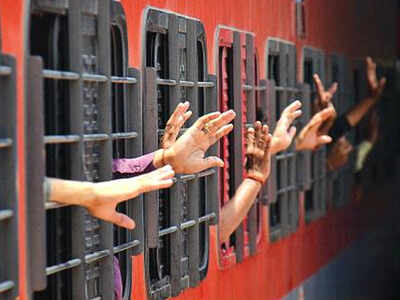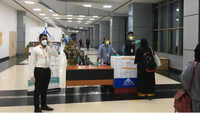
THIVIM: Over a thousand migrant workers heaved a collective sigh of relief as the first Shramik special train rolled out of Thivim railway station on Friday. The train, with 1,196 labourers and stranded tourists, is headed for Gwalior in Madhya Pradesh.
As the train slowly left, the station resounded with applause, with Konkan Railway staff, police personnel and state authorities clapping together. Many migrants waved back from their windows, faces lit up with wide smiles. Some even promised to return when lockdown is lifted.
“As soon as I found out that a train would take us to Gwalior, I called my family and told them. They were very happy. Goa has helped us in so many ways, we are really grateful,” said Suresh Kewat from MP’s Morena district.
The special train is just the first of several planned by state and central authorities to help people stranded in Goa get home to their families across India, officials said. This Friday’s train, operated by Konkan Railway, was only filled after its distressed passengers were screened.
“Goa is a nice place, there is no trouble and no disease, but the circumstances forced us to go home. We will have to stay another four days in Morena till we are cleared to go home,” said Vijay Singh, who worked in Vasco as a daily wage labourer, including for construction work at an Indian Navy base.
Their presence on the train was culmination of a secretive, detailed mission by various authorities. Government officials, Konkan Railway, Goa police, Kadamba Transport Corporation Ltd, the Railway Protection Force and several others coordinated to ensure that the exercise went off without a hitch, and without others getting into the train.
“This is the first train (of its kind from Goa), and we were very meticulous to screen each person and put them in dedicated bogies,” said nodal officer of the interstate movement cell, Kunal. “This is the first time we are having an evacuation exercise like this — mapping of districts, verifying phone numbers — and it was a challenge.”
To ensure complete secrecy and to prevent a mob at Thivim railway station, authorities began to gather people from across the state without divulging details about the train. On Wednesday night, district collectors of North Goa and South Goa, in coordination with Kunal, began to call and inform MP residents to assemble on Thursday.
565 stranded citizens were identified in North Goa, and 666 from South Goa which includes several children. Of these, eight were not allowed to board when healthcare workers found that they had a fever. Many of those left behind were pleading to be let on the train, but officials didn’t relent.
“The district magistrate sent out messages on Thursday to assemble at the staging area in the afternoon session. The first medical screening was done there, and then, Friday morning, they were brought here by dedicated buses,” said Kunal.
The passengers were segregated as per bogie and put on buses earmarked for specific bogies. They were handed over their tickets only at the railway station, to prevent unauthorised people from boarding the train. Goa police personnel lined both sides of the road leading to the station, and all the way to the train.
The 22-coach train had 20 sleeper coaches and two power cars, and is expected to arrive at Gwalior on Saturday morning. “Since the train is running point to point, we had to ensure that the receiving state has proper arrangements for transportation to respective locations,” said Kunal.
While most labourers were housed at relief camps in the state, some families and tourists were living at their own residences when they were asked to come to the staging area on Thursday.
No one except those with valid passes and tickets were allowed entry into the railway station and onto the train. They were given food and water for the journey. In the coming days, around 60,000 stranded people, mostly from UP and Bihar, hope to be able to catch trains and go home.
***
How it panned out
On Wednesday, officials start calling selected passengers
Thursday afternoon, they assembly at Peddem and Navelim
Those gathered are then screened for Covid-19 symptoms
Cleared, officials take their contact details and address
Based on Aadhaar card verification, travel passes are issued
A bogie number is alloted to each passenger with a pass
They board dedicated Kadamba buses alloted to each bogie
At 4am on Friday, passengers are woken up, put on buses
Later in the morning, the buses arrive at Thivim station
Here they are screened, given a ticket, and allowed to board
Sixty passengers are allowed in a bogie (capacity usually 80)
At 12.30pm, the train leaves; will reach Gwalior on Saturday
As the train slowly left, the station resounded with applause, with Konkan Railway staff, police personnel and state authorities clapping together. Many migrants waved back from their windows, faces lit up with wide smiles. Some even promised to return when lockdown is lifted.
“As soon as I found out that a train would take us to Gwalior, I called my family and told them. They were very happy. Goa has helped us in so many ways, we are really grateful,” said Suresh Kewat from MP’s Morena district.
The special train is just the first of several planned by state and central authorities to help people stranded in Goa get home to their families across India, officials said. This Friday’s train, operated by Konkan Railway, was only filled after its distressed passengers were screened.
“Goa is a nice place, there is no trouble and no disease, but the circumstances forced us to go home. We will have to stay another four days in Morena till we are cleared to go home,” said Vijay Singh, who worked in Vasco as a daily wage labourer, including for construction work at an Indian Navy base.
Their presence on the train was culmination of a secretive, detailed mission by various authorities. Government officials, Konkan Railway, Goa police, Kadamba Transport Corporation Ltd, the Railway Protection Force and several others coordinated to ensure that the exercise went off without a hitch, and without others getting into the train.
“This is the first train (of its kind from Goa), and we were very meticulous to screen each person and put them in dedicated bogies,” said nodal officer of the interstate movement cell, Kunal. “This is the first time we are having an evacuation exercise like this — mapping of districts, verifying phone numbers — and it was a challenge.”
To ensure complete secrecy and to prevent a mob at Thivim railway station, authorities began to gather people from across the state without divulging details about the train. On Wednesday night, district collectors of North Goa and South Goa, in coordination with Kunal, began to call and inform MP residents to assemble on Thursday.
565 stranded citizens were identified in North Goa, and 666 from South Goa which includes several children. Of these, eight were not allowed to board when healthcare workers found that they had a fever. Many of those left behind were pleading to be let on the train, but officials didn’t relent.
“The district magistrate sent out messages on Thursday to assemble at the staging area in the afternoon session. The first medical screening was done there, and then, Friday morning, they were brought here by dedicated buses,” said Kunal.
The passengers were segregated as per bogie and put on buses earmarked for specific bogies. They were handed over their tickets only at the railway station, to prevent unauthorised people from boarding the train. Goa police personnel lined both sides of the road leading to the station, and all the way to the train.
The 22-coach train had 20 sleeper coaches and two power cars, and is expected to arrive at Gwalior on Saturday morning. “Since the train is running point to point, we had to ensure that the receiving state has proper arrangements for transportation to respective locations,” said Kunal.
While most labourers were housed at relief camps in the state, some families and tourists were living at their own residences when they were asked to come to the staging area on Thursday.
No one except those with valid passes and tickets were allowed entry into the railway station and onto the train. They were given food and water for the journey. In the coming days, around 60,000 stranded people, mostly from UP and Bihar, hope to be able to catch trains and go home.
***
How it panned out
On Wednesday, officials start calling selected passengers
Thursday afternoon, they assembly at Peddem and Navelim
Those gathered are then screened for Covid-19 symptoms
Cleared, officials take their contact details and address
Based on Aadhaar card verification, travel passes are issued
A bogie number is alloted to each passenger with a pass
They board dedicated Kadamba buses alloted to each bogie
At 4am on Friday, passengers are woken up, put on buses
Later in the morning, the buses arrive at Thivim station
Here they are screened, given a ticket, and allowed to board
Sixty passengers are allowed in a bogie (capacity usually 80)
At 12.30pm, the train leaves; will reach Gwalior on Saturday

Coronavirus outbreak
Trending Topics
LATEST VIDEOS
More from TOI
Navbharat Times
Featured Today in Travel
Quick Links
Kerala Coronavirus Helpline NumberHaryana Coronavirus Helpline NumberUP Coronavirus Helpline NumberBareilly NewsBhopal NewsCoronavirus in DelhiCoronavirus in HyderabadCoronavirus in IndiaCoronavirus symptomsCoronavirusRajasthan Coronavirus Helpline NumberAditya ThackerayShiv SenaFire in MumbaiAP Coronavirus Helpline NumberArvind KejriwalJammu Kashmir Coronavirus Helpline NumberSrinagar encounter
Get the app







